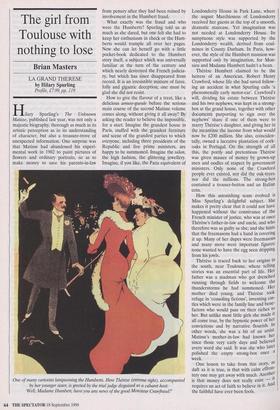The girl from Toulouse with nothing to lose
Brian Masters
LA GRAND THERESE by Hilary Spurting Profile, £7.99, pp. 119 Hilary Spurling's The Unknown Matisse, published last year, was not only a majestic biography, thorough as much in its artistic perception as in its understanding of character, but also a treasure-trove of unexpected information. One surprise was that Matisse had abandoned his experi- mental work in 1902 to paint pictures of flowers and ordinary portraits, so as to make money to save his parents-in-law from penury after they had been ruined by involvement in the Humbert fraud.
What exactly was the fraud and who were the Humberts? Spurling told us as much as she dared, but one felt she had to keep her enthusiasm in check or the Hum- berts would trample all over her pages. Now she can let herself go with a little pocket-book dedicated to the Humbert story itself, a subject which was universally familiar at the turn of the century and which nearly destroyed the French judicia- ry, but which has since disappeared from record. It is an irresistible mixture of farce, folly and gigantic deception; one must be glad she did not resist.
How to give the flavour of a treat, like a delicious amuse-gueule before the serious main course of the second Matisse volume comes along, without giving it all away? By asking the reader to believe the impossible, for a start. Imagine the grandest house in Paris, stuffed with the grandest furniture and scene of the grandest parties to which everyone, including three presidents of the Republic and five prime ministers, are happy to be summoned. Imagine the salon, the high fashion, the glittering jewellery. Imagine, if you like, the Paris equivalent of
One of many cartoons lampooning the Humberts. Here Therese (extreme right), accompanied by her younger sister, is greeted by the trial judge disguised as a cabaret host: `Well, Madame Humbert, have you any news of the good Monsieur Crawfraud?'
Londonderry House in Park Lane, where the august Marchioness of Londonderry received her guests at the top of a smooth, dramatic staircase. Yet imagination was not needed at Londonderry House. Its sumptuous style was supported by the Londonderry wealth, derived from coal- mines in County Durham. In Paris, how- ever, the style of the Humbert mansion was supported only by imagination, for Mon- sieu and Madame Humbert hadn't a bean.
Therese Humbert claimed to be the heiress of an American, Robert Henry Crawford, whose life she had saved follow- ing an accident in what Spurling calls 'a phenomenally early motor-car'. Crawford's will, dividing his estate between Therese and his two nephews, was kept in a strong- box at the grand house, together with other documents purporting to sign over the nephews' share if one of them were to marry Therese's daughter, and giving her in the meantime the income from what would now be £200 million. She also, coinciden- tally, owned a lucrative plantation of cork- oaks in Portugal. On the strength of all this, the portly and pretentious Therese was given masses of money by grown-up men and oodles of respect by government ministers. Only none of the Crawford people ever existed, nor did the oak-trees, nor did the millions. The strong-box contained a trouser-button and an Italian coin.
How this astonishing scam evolved is Miss Spurling's delightful subject. She makes it pretty clear that it could not have happened without the connivance of the French minister of justice, who was at once Therese's father-in-law and uncle, and who therefore was as guilty as she; and she hints that the freemasons had a hand in covering it up. Many of her dupes were freemasons and many more were important figures; none wanted to have the egg seen dripping from his jowls. Therese is traced back to her origins in the south, near Toulouse, where telling stories was an essential part of life. Her father was a madman who got drenched running through fields to welcome the thunderstorms he had summoned. Her mother died young, and Therese took refuge in 'consoling fictions', inventing cas- tles which were in the family line and bene- factors who would pass on their riches to her. But unlike most little girls she made it all come true, by the hypnotic power of her convictions and by narrative flourish. 111 other words, she was a bit of an artist. Matisse's mother-in-law had known her since those very early days and believed every word she said. It was she who later polished the empty strong-box once a week.
One lesson to take from this story, as daft as it is true, is that with calm effron- tery one may get away with much. Another is that money does not really exist — it requires an act of faith to believe in it. And the faithful have ever been fools.


























































































 Previous page
Previous page